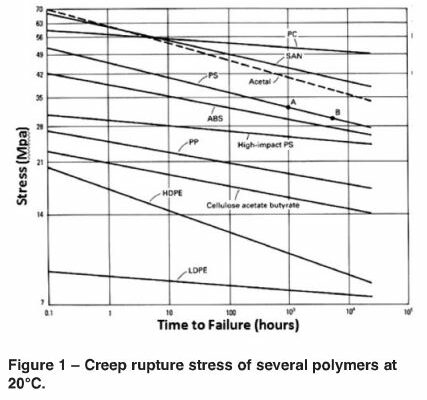This article was originally published in Plastics Engineering magazine dated March 2013.
Plastic parts fail through a variety of mechanisms including stress overload, chemical attack, environmental stress cracking, fatigue, and creep. Many of these failures can be avoided by understanding how the specific plastic being used behaves under a certain load at the expected environmental conditions. Lifetime prediction or predicting when a failure will occur can be a powerful method to understand why a part failed. The true benefit of lifetime prediction is using it to prevent failures from taking place. This paper will focus on predicting plastic failures that occur through creep.
 Polymer creep, along with variances of it, is a leading mechanism of failure. Figure 1 illustrates the stress versus time to creep rupture of various materials.1 The y-axis (time = 0.0) represents the properties obtained from classical stress-strain testing following ASTM D 638.2 This graph clearly illustrates that the strength of a plastic sample decreases over time. For instance, if one follows the plot for polyacetal (POM) one can see that the stress required to induce failure decreases from approximately 70 MPa to 35 MPa at room temperature. This graph also illustrates an important concept with plastics: one cannot predict the behavior over time with simple single point data/testing, e.g., ASTM D 638. Multipoint data or data taken over time and/or temperature is needed to make these types of predictions. Many engineers that are not familiar with designing with plastics are very surprised by this concept and may not truly appreciate it until a failure occurs because of it.
Polymer creep, along with variances of it, is a leading mechanism of failure. Figure 1 illustrates the stress versus time to creep rupture of various materials.1 The y-axis (time = 0.0) represents the properties obtained from classical stress-strain testing following ASTM D 638.2 This graph clearly illustrates that the strength of a plastic sample decreases over time. For instance, if one follows the plot for polyacetal (POM) one can see that the stress required to induce failure decreases from approximately 70 MPa to 35 MPa at room temperature. This graph also illustrates an important concept with plastics: one cannot predict the behavior over time with simple single point data/testing, e.g., ASTM D 638. Multipoint data or data taken over time and/or temperature is needed to make these types of predictions. Many engineers that are not familiar with designing with plastics are very surprised by this concept and may not truly appreciate it until a failure occurs because of it.
Material Databases
There are numerous sources of multipoint data, including books3 and electronic databases on the internet.4 Much of the data in these resources follow ASTM D 2290 “Standard Methods for Tensile, Compressive, and Flexural Creep and Creep Rupture of Plastics”5 where the tests are performed over an extended period of time, e.g. 1,000 to 10,000 hours. This data can be very useful, if it is available, for the temperature and the intended lifetime at which the plastic part will be used. If prediction is needed at an unavailable temperature, extrapolation of the available data can be difficult.
Contributors include: Paul Gramann, Ph.D., Javier Cruz, Ph.D., and Jeffrey A. Jansen, M.S. of The Madison Group, Madison, WI
